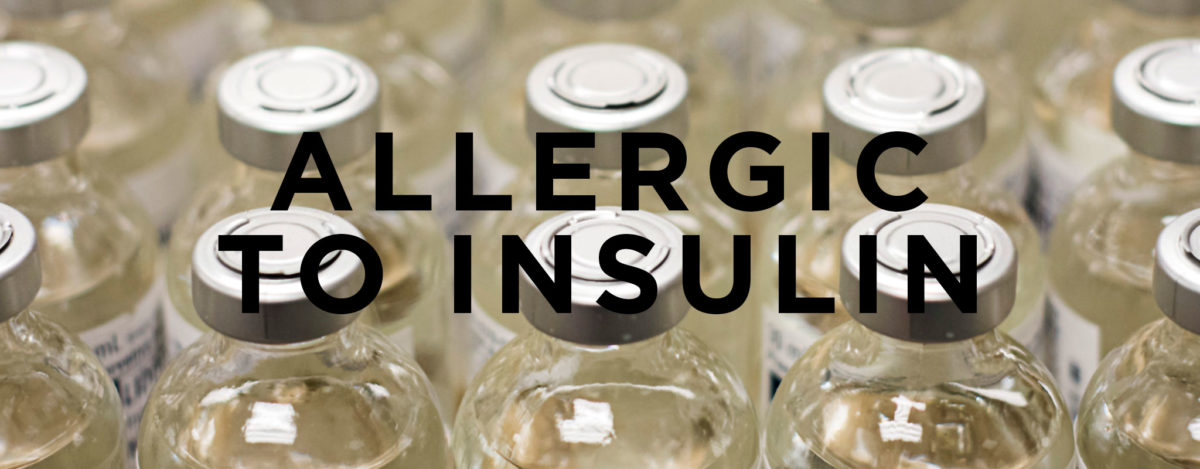Insulin Allergies + Type 1
Read Help Get Answers for Jack—a story of an 8-year-old boy who suffers a severe allergy to insulin, the life-saving medicine required for managing his type 1 diabetes.
Editor’s Note: If you suspect you have an allergy to insulin or any item that is a part of your type 1 diabetes management, consult your physician and diabetes team. This article has been verified by Dan Desalvo, MD, assistant professor of pediatrics in Pediatric Diabetes & Endocrinology at Baylor College of Medicine/Texas Children’s Hospital.
Now imagine being allergic to the very thing that keeps you alive. Allergic reactions to insulin are rare, but they do exist.
What is an insulin allergy?
Adverse reactions to insulin can occur as soon as 30 seconds after an insulin injection or later, after several minutes or even after hours have passed (INDependent Diabetes Trust). It’s possible that someone with type 1 could be allergic to one type of insulin, but not another. Just over 2 percent of people with diabetes exhibit some signs of an allergy to insulin, most commonly a local reaction (Insulin Nation).
Why do allergic reactions to insulin occur?
Before the 1980s, bovine (beef) and porcine (pork) insulin preparations were common, and often triggered allergic reactions. Fortunately, adverse reactions to insulin have significantly diminished since the introduction of scientifically engineered human insulin preparations in the 1980s. However, even with the genetically modified human insulins available today, allergic reactions still occur (though rarely) and can be quite dangerous. In some cases, the allergic reaction is to the insulin molecule itself, but it may also be to different types of fillers, preservatives, or amino acid combinations found in various insulin preparations (Joslin Diabetes Center).
Signs and Symptoms
If you’re allergic to insulin, you might experience a localized reaction near the injection site. You may also develop a systemic reaction, which is much more rare, and affects the entire body, usually over a longer period of time.
Symptoms to look out for include:
- Irritation, swelling, or hives at injection site
- Rash throughout the body
- Low blood pressure
- Shortness of breath
- Anaphylaxis (throat and mouth swelling that restricts airways)—a life-threatening reaction
What does it mean for people with Type 1?
As we all know, with type 1, insulin is necessary for survival, so stopping insulin is not a choice. Discovering the exact cause of the allergic reaction is important, so doctors will typically run tests to identify if a particular type of insulin, preservative or delivery method is the culprit.
Treatment options include taking antihistamines to help minimize allergy symptoms, as well as steroids to dampen the immune system’s negative response to insulin (Joslin Diabetes Center). In some cases, giving small doses of insulin subcutaneously (via a pump) with low basal rates and avoiding large bolus doses, may desensitize the body, and the adverse reactions will stop. Sometimes, simply switching from one type of insulin to another can solve the problem.
“Specific immunotherapy” has been successful in treating severe cases of insulin allergy that do not respond to other treatments. Specific immunotherapy consists of giving a very tiny dose of insulin initially (i.e. 0.00001 units), and slowly increasing the dose over a couple of days to allow the body to desensitize to insulin. It requires close monitoring in the hospital setting in case of an emergency.
What to do in the event of a possible insulin allergy
Let your doctor and your diabetes team know right away. You’ll likely need to see an allergist and get a skin prick test or undergo intradermal testing to determine the exact cause of the reaction.
The course of treatment depends on the severity and the ultimate cause of the reaction. Several studies report that taking insulin inconsistently can aggravate allergy symptoms or cause them to reappear.
If you feel that the type of insulin you’re taking isn’t right for you or that you could better manage your type 1 with another treatment approach, don’t be afraid to speak up and tell your diabetes team. Do your own research, know your body and be an informed consumer of your insulin.
Be sure to rule out the possibilities of an allergic reaction to the following:
- Type or brand of insulin
- Infusion set cannula (tubing that goes under skin) in pumps
- Metal of needle
- Tape or adhesive
- Preservative in the insulins (type of preservative used may vary in insulins)
Possible treatments your doctor may recommend:
- Trying a different type of insulin
- The use of antihistamines
- Desensitization (slowly and consistently introducing an insulin, usually with an insulin pump at low basal rate)
- The temporary use of a steroid
- Adding cortisone (steroid) to the insulin injection
- Switching to multiple daily injections (MDI) from a pump (if the cannula)
- Trying different adhesives
REFERENCES—
Diabetes U.K.: Animal Insulin, History of Insulin
Diabetic Lifestyle: Insulin: Its History and Future
Heinzerling, L., Raile, K., Rochlitz, H., Zuberbier, T., Worm, M. “Insulin allergy: clinical manifestations and management strategies.” Allergy: European Journal of Allergy and Clinical Immunology, 2008 Jan: 63(2): 1398-9995.
Joslin Diabetes Center: Insulin Allergies
InDependent Diabetes Trust: Choices—The Evidence, Allergic Reactions to Insulin
Insulin Nation: Insulin Allergies are For Real





